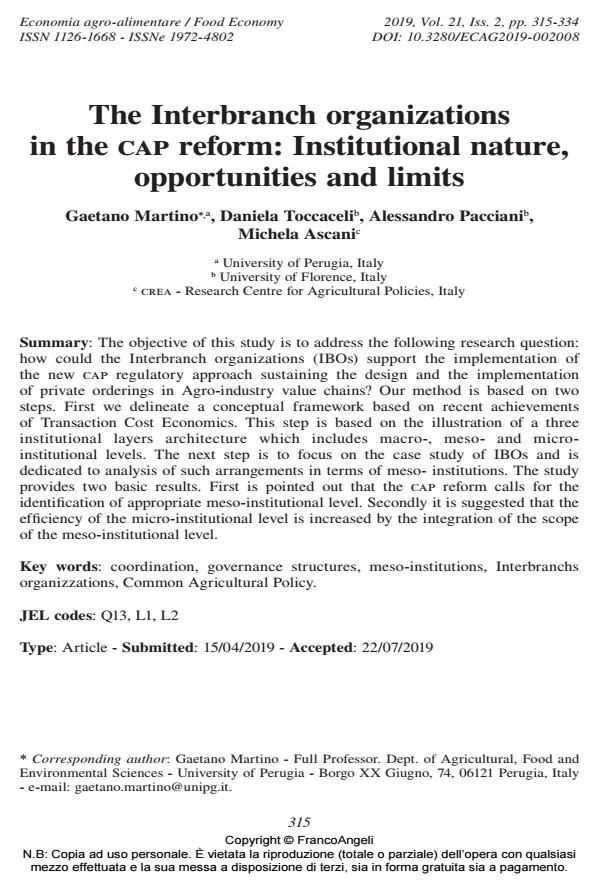The Interbranch organizations in the cap reform: Institutional nature, opportunities and limits
Titolo Rivista ECONOMIA AGRO-ALIMENTARE
Autori/Curatori Gaetano Martino, Daniela Toccaceli, Alessandro Pacciani, Michela Ascani
Anno di pubblicazione 2019 Fascicolo 2019/2
Lingua Inglese Numero pagine 20 P. 315-334 Dimensione file 154 KB
DOI 10.3280/ECAG2019-002008
Il DOI è il codice a barre della proprietà intellettuale: per saperne di più
clicca qui
Qui sotto puoi vedere in anteprima la prima pagina di questo articolo.
Se questo articolo ti interessa, lo puoi acquistare (e scaricare in formato pdf) seguendo le facili indicazioni per acquistare il download credit. Acquista Download Credits per scaricare questo Articolo in formato PDF

FrancoAngeli è membro della Publishers International Linking Association, Inc (PILA)associazione indipendente e non profit per facilitare (attraverso i servizi tecnologici implementati da CrossRef.org) l’accesso degli studiosi ai contenuti digitali nelle pubblicazioni professionali e scientifiche
The objective of this study is to address the following research question: how could the Interbranch organizations (IBOs) support the implementation of the new cap regulatory approach sustaining the design and the implementation of private orderings in Agro-industry value chains? Our method is based on two steps. First we delineate a conceptual framework based on recent achievements of Transaction Cost Economics. This step is based on the illustration of a three institutional layers architecture which includes macro-, meso- and microinstitutional levels. The next step is to focus on the case study of IBOs and is dedicated to analysis of such arrangements in terms of meso- institutions. The study provides two basic results. First is pointed out that the cap reform calls for the identification of appropriate meso-institutional level. Secondly it is suggested that the efficiency of the micro-institutional level is increased by the integration of the scope of the meso-institutional level.
Parole chiave:Coordination, governance structures, meso-institutions, Interbranchs organizzations, Common Agricultural Policy.
Jel codes:Q13, L1, L2
- Governance in the Italian Processed Tomato Value Chain: The Case for an Interbranch Organisation Antonella Samoggia, Francesca Monticone, Gianandrea Esposito, in Sustainability /2022 pp.2749
DOI: 10.3390/su14052749 - Importance of different policy instruments in the introduction of sustainable innovation in fruit and vegetable value chains: The perception of coordinators of European research and innovation projects Riccardo Borgia, Matteo Zavalloni, Davide Viaggi, in Journal of Rural Studies 103695/2025 pp.103695
DOI: 10.1016/j.jrurstud.2025.103695
Gaetano Martino, Daniela Toccaceli, Alessandro Pacciani, Michela Ascani, The Interbranch organizations in the cap reform: Institutional nature, opportunities and limits in "ECONOMIA AGRO-ALIMENTARE" 2/2019, pp 315-334, DOI: 10.3280/ECAG2019-002008